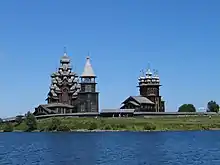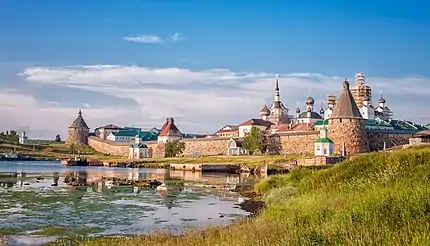Russian North
Russian North (Russian: Русский Север) is an ethnocultural region situated in the northwestern part of Russia. It spans the regions of Arkhangelsk Oblast, the Republic of Karelia, Komi Republic, Vologda Oblast and Nenets Autonomous Okrug).[1] It is known for its traditions of folk art - in particular, wooden architecture, wood and bone carving and painting.[2] Due to its remoteness, the rural parts of Russian North preserve much of the archaic aspects of Russian culture during the 19th and 20th centuries, making it of particular interest to historians, culturologists and ethnographers.[3]

History
The initial Russian colonization of the Russian North started independently from Novgorod and Rostov. Genetic studies show that the populations of Russian North have a significant Finnic admixture, which is not typical for more southern Russian populations.[4] The pre-Russian (most likely Finno-Ugric) populations of Russian North were recorded as "Zavoloshka Chudes" in chronicles. Russian North is rich in toponyms and hydronyms of possibly Finno-Ugric substrate origin, which were extensively studied by many linguists, most notably A. K. Matveyev.[5]
The Russian North was gradually colonized by Slavs since at least the XI-XII centuries. Initially the area was incorporated into the Novgorod Republic which, in its turn, in the XV century was incorporated into Grand Duchy of Moscow. The climate of the Russian North is harsh, with minimum possibilities for agriculture, therefore fishing, hunting for marine mammals, as well as the salt-cooking industry, became alternatives for the people living in the area. By the late XVI century the White Sea port of Archangelsk became the major gateway for the Russian commerce with Europe. Since the Russian North seemed the perfect place for a religious escape from the world, orthodox monasteries, with their ambitions and possibilities (through religion and economic power), were critical for the Russian North economy.[6] Northern Thebaid is the poetic name of the northern Russian lands surrounding Vologda and Belozersk, appeared as a comparison with the Egyptian area Thebaid - well-known settling place of early Christian monks and hermits.
Most of the Russian North territories never had serfdom, at least the way it existed in central Russian agricultural regions.
Demographics
The White Sea coastal part of the Russian North is home to Pomors, a unique subethnic group of Russians with a maritime culture not typical of other Russian subethnic groups. Moreover, the Russian North is home to numerous Old Believer communities.[7]
Tourism
Russian North is a major tourist destination due to the large amount of both natural and cultural places of interest (Kizhi Pogost, Valaam, Kirillo-Belozersky Monastery, etc.)
Gallery
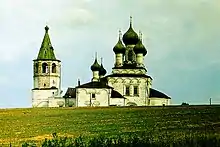 A church in Matigory (built 1686-1694)
A church in Matigory (built 1686-1694) Church of the Annunciation (Solvychegodsk)
Church of the Annunciation (Solvychegodsk) A fresco on a church in Dymkovo (Veliky Ustyug)
A fresco on a church in Dymkovo (Veliky Ustyug) An open-air wooden architecture museum in Malye Korely
An open-air wooden architecture museum in Malye Korely Young peasant women in Vologda Governorate, early 20th century
Young peasant women in Vologda Governorate, early 20th century Nature in the national park near the Kirillo-Belozersky Monastery
Nature in the national park near the Kirillo-Belozersky Monastery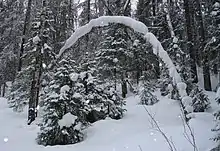 A taiga forest near Pinega
A taiga forest near Pinega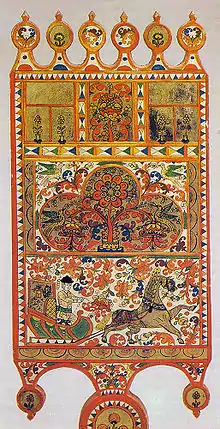 Spinning wheel board from Arkhangelsk Oblast (19th century)
Spinning wheel board from Arkhangelsk Oblast (19th century)
See also
- Novgorod Republic
- Northern Russian dialects
- Northern Thebaid
- Russky Sever National Park
- Northern economic region (Russia)
- Far North (Russia)
- Atlantis of the Russian North - a 2015 documentary movie about the region
References
- Сергей Лебедев "Русский Север". Русская народная линия, 06.12.2014 (in Russian)
- Овсянников О. В. Люди и города Средневекового Севера : Монография. — Архангельск: Северо-Западное книжное издательство, 1971. p. 78. (in Russian)
- "Russia's federal constituent entities". Federation Council of the Federal Assembly of the Russian Federation. Retrieved 2021-02-13.
- Балановский О. П. «Панорама народов на фоне Европы. Восточные и западные славяне (серия II)» // «Генофонд Европы», М., 2015 (in Russian)
- Aleksandr Matveyev "Substrate toponymics of Northern Russia" (vol. 1, 2), Yekaterinburg, 2001.
- Monasteries and the maritime history of the Russian North from the 16th century to the early 18th century
- "Why Is Moscow so Afraid of 2,000 Pomors in Karelia?". Jamestown. Retrieved 2021-02-13.
External links
- Atlantis of the Russian North (full documentary w/ English subtitles)
